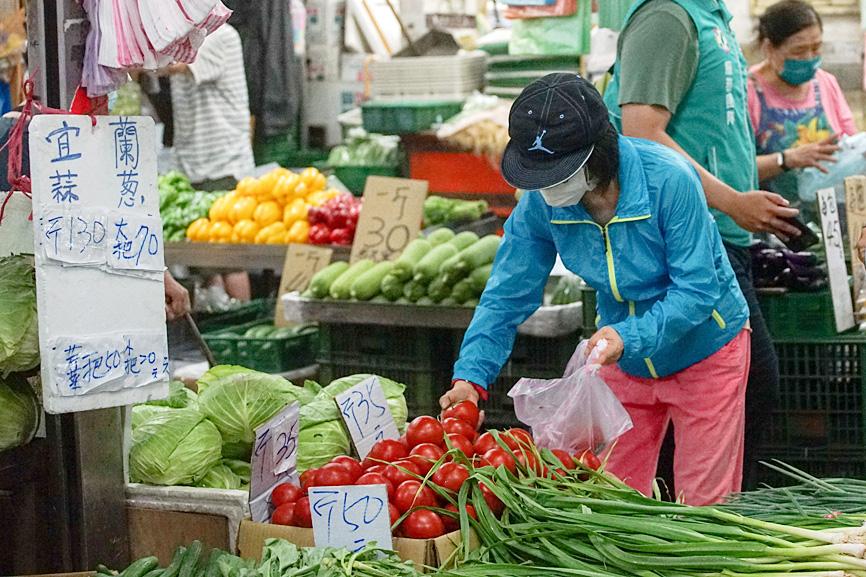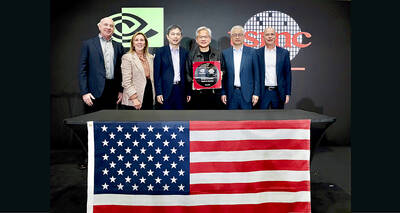The Directorate-General of Budget, Accounting and Statistics (DGBAS) yesterday trimmed its forecast for the nation’s economic growth to 3.76 percent from an estimate of 3.91 percent in May, given slowing global trade and weaker export momentum.
It is the second time that DGBAS cut its prediction, after it lowered the figure to 3.85 percent last month. The 0.15 percentage point revision brings the forecast lower than those estimated by most think tanks.
“We have a mild revision because we found that most sectors still report stable growth rather than a drastic correction,” DGBAS Minister Chu Tzer-ming (朱澤民) told a news conference in Taipei.

Photo: CNA
Slower demand for exports is the main reason for the revision, as the IMF had cut its forecast for global trade growth this year to 4.1 percent from five percent given surging inflation, the war in Ukraine war and tightened monetary measures, Chu said.
The agency cut its forecast for the nation’s exports to US$506.7 billion for this year, compared with an earlier estimate of US$516.1 billion.
However, the revised export figures still represent annual growth of 13.51 percent, Chu said.
Imports are forecast to grow faster than exports, by 16.8 percent annually to US$445.6 billion, as domestic manufacturers have significant demand for foreign-made machinery, DGBAS Statistics Department head Tsai Yu-tai (蔡鈺泰) said.
Trade surplus in goods and services is expected to book US$114.1 billion, down from US$115.1 billion last year, the agency said.
As a result, net demand from foreign markets is predicted to contribute 0.85 percentage points to GDP growth, down from 1.85 percent last year and 2.67 percent in 2020, Tsai said.
However, DGBAS boosted its growth forecast for domestic investment to 6.55 percent for the year, up by nearly 2 percentage points from an earlier estimate, as the agency had seen stronger-than-expected momentum, especially from semiconductor companies, offshore wind power developers and solar power farmers, Tsai said.
The agency expects private consumption to peak this quarter, up 6.49 percent year-on-year, given relaxed COVID-19 measures and government programs to spur local travel, Tsai said.
Private consumption this year is expected to rise 3.03 percent from a year earlier, the first annual growth since 2020, the DGBAS said.
The DGBAS yesterday raised this year’s consumer price index growth forecast to 2.92 percent, up from the 2.67 percent it estimated in May, mainly because of a surge in the costs of rental homes and dining out, Chu said.
If accurate, 2.92 percent would be the highest growth since 2009, after 3.52 percent in 2008, Tsai said.
Asked why DGBAS did not raise the figure above three percentage points, as most think tanks had estimated, Chu said that international prices of goods slid month-on-month, and “the second quarter should have been the peak for inflation growth.”

France cannot afford to ignore the third credit-rating reduction in less than a year, French Minister of Finance Roland Lescure said. “Three agencies have downgraded us and we can’t ignore this cloud,” he told Franceinfo on Saturday, speaking just hours after S&P lowered his country’s credit rating to “A+” from “AA-” in an unscheduled move. “Fundamentally, it’s an additional cloud to a weather forecast that was already pretty gray. It’s a call for lucidity and responsibility,” he said, adding that this is “a call to be serious.” The credit assessor’s move means France has lost its double-A rating at two of the

Jensen Huang (黃仁勳), founder and CEO of US-based artificial intelligence chip designer Nvidia Corp and Taiwan Semiconductor Manufacturing Co (TSMC, 台積電) on Friday celebrated the first Nvidia Blackwell wafer produced on US soil. Huang visited TSMC’s advanced wafer fab in the US state of Arizona and joined the Taiwanese chipmaker’s executives to witness the efforts to “build the infrastructure that powers the world’s AI factories, right here in America,” Nvidia said in a statement. At the event, Huang joined Y.L. Wang (王英郎), vice president of operations at TSMC, in signing their names on the Blackwell wafer to

AI BOOST: Although Taiwan’s reliance on Chinese rare earth elements is limited, it could face indirect impacts from supply issues and price volatility, an economist said DBS Bank Ltd (星展銀行) has sharply raised its forecast for Taiwan’s economic growth this year to 5.6 percent, citing stronger-than-expected exports and investment linked to artificial intelligence (AI), as it said that the current momentum could peak soon. The acceleration of the global AI race has fueled a surge in Taiwan’s AI-related capital spending and exports of information and communications technology (ICT) products, which have been key drivers of growth this year. “We have revised our GDP forecast for Taiwan upward to 5.6 percent from 4 percent, an upgrade that mainly reflects stronger-than-expected AI-related exports and investment in the third

RARE EARTHS: The call between the US Treasury Secretary and his Chinese counterpart came as Washington sought to rally G7 partners in response to China’s export controls China and the US on Saturday agreed to conduct another round of trade negotiations in the coming week, as the world’s two biggest economies seek to avoid another damaging tit-for-tat tariff battle. Beijing last week announced sweeping controls on the critical rare earths industry, prompting US President Donald Trump to threaten 100 percent tariffs on imports from China in retaliation. Trump had also threatened to cancel his expected meeting with Chinese President Xi Jinping (習近平) in South Korea later this month on the sidelines of the APEC summit. In the latest indication of efforts to resolve their dispute, Chinese state media reported that